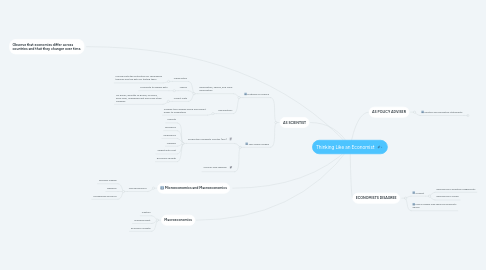
1. Microeconomics and Macroeconomics
1.1. Microeconomics
1.1.1. Decision making
1.1.2. Behavior
1.1.3. Households and firms
2. Macroeconomics
2.1. Inflation
2.2. Unemployment
2.3. Economic Growth
3. Observe that economies differ across countries and that they changer over time.
4. AS SCIENTIST
4.1. Methods of Science
4.1.1. Observation, Theory, and More Observation
4.1.1.1. Observation
4.1.1.1.1. Provide both the motivation for developing theories and the data for testing them
4.1.1.2. Theory
4.1.1.2.1. Formulate to explain data
4.1.1.3. Collect Data
4.1.1.3.1. On prices, quantity of goods, incomes, price level, unemployment and many other variables
4.1.2. Assumptions
4.1.2.1. Simplify the complex world and make it easier to understand
4.2. Two simple models
4.2.1. Production Possibility Frontier (PFF)
4.2.1.1. Scarcity
4.2.1.2. Efficiency
4.2.1.3. Inefficiency
4.2.1.4. Tradeoff
4.2.1.5. Opportunity cost
4.2.1.6. Economic growth
4.2.2. Circular-flow diagram
5. AS POLICY ADVISER
5.1. Positive and Normative Statements
5.1.1. A key difference between positive and normative
5.1.2. Positive Statements
5.1.2.1. Claims that attempt to describe the world as it is
5.1.2.1.1. Why do people use money?
5.1.2.1.2. No value judgements
5.1.3. Normative Statements
5.1.3.1. Claims that attempt to prescribe how the world should be
5.1.3.1.1. Should people use money?
5.1.3.1.2. Value judgements
6. ECONOMISTS DISAGREE
6.1. Conflict
6.1.1. Differences in scientific judgements
6.1.2. Differences in values
